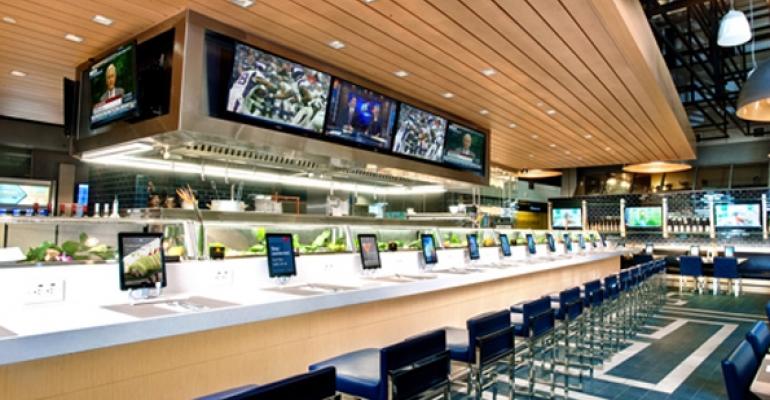Positive consumer response and higher sales means airport concessionaire OTG Management will be using wireless tablet computers for guest self-ordering and payment at all of its locations going forward, the company said.
RELATED
• IT in 3: Domino's Pizza CIO discusses IT strategy
• Dinner and a movie: Studio Movie Grill expands
• More restaurant industry operations news
New York-based OTG has been deploying Apple iPad tablet computers with customized software to five table-service restaurants and common seating areas at JFK, LaGuardia and Minneapolis-St. Paul airports since June.
As of last week, OTG said, it had about 1,000 of the tablets installed at those three airports and was preparing to deploy them to Toronto Pearson International Airport. The company said it was on track to have a total of 7,000 iPads in use at the LaGuardia, Minneapolis-St. Paul and Toronto Pearson airports by the end of 2013.
“Every single restaurant that we have, from here forward, at every seat, whether it is at the bar or a table, will have an iPad,” said Rick Blatstein, chief executive of OTG, which operates 150 restaurants, gourmet markets, food courts and other foodservice points of distribution at 10 airports.
Blatstein said the company has already invested $10 million in the technology, “and that is just the start,” he noted, as he envisions that within the next three to five years, up to 50,000 iPads may be in use. The tablets will be used for quick-service, fast-casual and table-service locations.

Among the OTG-associated restaurants already using the tablet technology are Bisoux and Empire at LaGuardia, as well as Mimosa, Shoyu and Volante at Minneapolis-St. Paul.
“We’re seeing double-digit increases in our sales,” Blatstein said of the iPad deployments. “Customer satisfaction is through the roof.” He added that the sales increases associated with tablet use stem from a combination of faster seat turns and higher per-person averages.
The tablet computers, provided by OTG at no charge to the customer, permit travelers to self-order meals by touching photo-studded menus and to pay by swiping a credit or debit card. Guests who order from outside of a restaurant also can pick up their items or have them delivered in the terminal. The tablets also let users monitor their flights, check e-mail, browse the Web and play games, and often are part of seating areas that include power outlets so travelers can recharge their own mobile devices while using the OTG gear.
 The use of tablet technology and equipment such as iPads has been slowly gaining momentum for several years throughout foodservice.
The use of tablet technology and equipment such as iPads has been slowly gaining momentum for several years throughout foodservice.
Among airport concessionaires, Delaware North Cos. of Buffalo, N.Y., is believed to have been the first to give the technology a try, with the 2008 debut of self-order and gaming terminals at a franchised Chili’s Too Margarita Bar at Fort Lauderdale Hollywood International Airport in Florida. Delaware North representative Jesse Baier said the company has since changed its kiosk technology at many of its new airport concepts, including just-opened Skewers by Morimoto and Wolfgang Puck Express at Los Angeles International Airport.
HMSHost of Bethesda, Md., this summer added tablet computers to tables at its Taberna del Tequila restaurant at Phoenix Sky Harbor International Airport. The systems permit guests to browse photo-filled menus and then place and pay for their orders using a touch-screen display and built-in payment-card reader. HMSHost said the guest self-ordering technology also is slated for use at restaurants at Charlotte Douglas International Airport and others.
OTG’s Blatstein said his company, in exploring a new service model that incorporates tablet computers, decided, “Let’s let the customers teach us a new way.”
He said that at first, the company was concerned that guests using the tablets to surf the Web would slow table turnover. Instead, "We found that we turn tables quicker because the guest was in full control,” he said.
“We wondered if putting an iPad in front of guests would cause them to keep them to themselves a little more, rather than talk to their neighbors and be socially interactive,” Blatstein continued. “But we constantly see customers showing each other what they have on their iPads — The social interaction is even greater than it was without them.”

OTG has not reduced the number of servers it uses in its restaurants, Blatstein said, and believes that because the tablet technology has “taken the burden off of the servers” to record and enter order details, the wait staff “can really work on hospitality.”
In addition, using technology that sends orders directly to the kitchen as customers place their orders creates a steady flow to order taking and execution. “You — the guest — always get the upsells, and you always get to choose what you want on things and how you want them modified, so it is a real consistent and wonderful way to operate a restaurant,” Blatstein said.
“We were a little concerned about how quickly customers would accept the experience,” Blatstein admitted. “But it was crazy because as soon as we put it out, it was as if it been there for 1,000 years and this is the way [customers] have always ordered,” he added.
On the rare occasion a customer does not want to use the tablets to order or pay, he said, “a server is happy to help.”
Contact Alan Liddle at [email protected].
Follow him on Twitter: @AJ_NRN





